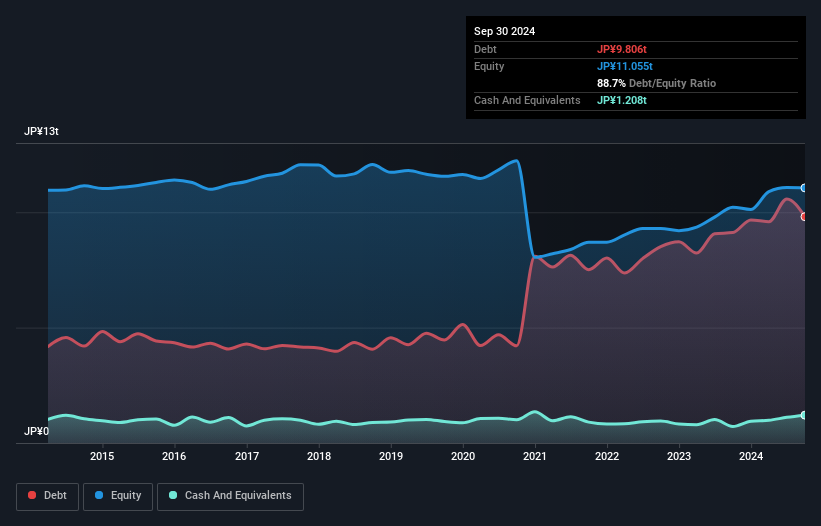- Japan
- /
- Telecom Services and Carriers
- /
- TSE:9432
Nippon Telegraph and Telephone (TSE:9432) Takes On Some Risk With Its Use Of Debt
Some say volatility, rather than debt, is the best way to think about risk as an investor, but Warren Buffett famously said that 'Volatility is far from synonymous with risk.' When we think about how risky a company is, we always like to look at its use of debt, since debt overload can lead to ruin. We can see that Nippon Telegraph and Telephone Corporation (TSE:9432) does use debt in its business. But should shareholders be worried about its use of debt?
Why Does Debt Bring Risk?
Debt is a tool to help businesses grow, but if a business is incapable of paying off its lenders, then it exists at their mercy. If things get really bad, the lenders can take control of the business. However, a more frequent (but still costly) occurrence is where a company must issue shares at bargain-basement prices, permanently diluting shareholders, just to shore up its balance sheet. Of course, debt can be an important tool in businesses, particularly capital heavy businesses. The first step when considering a company's debt levels is to consider its cash and debt together.
See our latest analysis for Nippon Telegraph and Telephone
How Much Debt Does Nippon Telegraph and Telephone Carry?
You can click the graphic below for the historical numbers, but it shows that as of September 2024 Nippon Telegraph and Telephone had JP¥9.81t of debt, an increase on JP¥9.12t, over one year. However, because it has a cash reserve of JP¥1.21t, its net debt is less, at about JP¥8.60t.

A Look At Nippon Telegraph and Telephone's Liabilities
The latest balance sheet data shows that Nippon Telegraph and Telephone had liabilities of JP¥8.03t due within a year, and liabilities of JP¥9.96t falling due after that. Offsetting these obligations, it had cash of JP¥1.21t as well as receivables valued at JP¥4.31t due within 12 months. So it has liabilities totalling JP¥12t more than its cash and near-term receivables, combined.
This is a mountain of leverage even relative to its gargantuan market capitalization of JP¥13t. This suggests shareholders would be heavily diluted if the company needed to shore up its balance sheet in a hurry.
We measure a company's debt load relative to its earnings power by looking at its net debt divided by its earnings before interest, tax, depreciation, and amortization (EBITDA) and by calculating how easily its earnings before interest and tax (EBIT) cover its interest expense (interest cover). The advantage of this approach is that we take into account both the absolute quantum of debt (with net debt to EBITDA) and the actual interest expenses associated with that debt (with its interest cover ratio).
With a debt to EBITDA ratio of 2.4, Nippon Telegraph and Telephone uses debt artfully but responsibly. And the fact that its trailing twelve months of EBIT was 9.4 times its interest expenses harmonizes with that theme. Nippon Telegraph and Telephone grew its EBIT by 6.1% in the last year. That's far from incredible but it is a good thing, when it comes to paying off debt. There's no doubt that we learn most about debt from the balance sheet. But it is future earnings, more than anything, that will determine Nippon Telegraph and Telephone's ability to maintain a healthy balance sheet going forward. So if you want to see what the professionals think, you might find this free report on analyst profit forecasts to be interesting.
Finally, a company can only pay off debt with cold hard cash, not accounting profits. So we clearly need to look at whether that EBIT is leading to corresponding free cash flow. Looking at the most recent three years, Nippon Telegraph and Telephone recorded free cash flow of 27% of its EBIT, which is weaker than we'd expect. That's not great, when it comes to paying down debt.
Our View
Neither Nippon Telegraph and Telephone's ability to handle its total liabilities nor its conversion of EBIT to free cash flow gave us confidence in its ability to take on more debt. But its interest cover tells a very different story, and suggests some resilience. Taking the abovementioned factors together we do think Nippon Telegraph and Telephone's debt poses some risks to the business. While that debt can boost returns, we think the company has enough leverage now. When analysing debt levels, the balance sheet is the obvious place to start. But ultimately, every company can contain risks that exist outside of the balance sheet. These risks can be hard to spot. Every company has them, and we've spotted 1 warning sign for Nippon Telegraph and Telephone you should know about.
If, after all that, you're more interested in a fast growing company with a rock-solid balance sheet, then check out our list of net cash growth stocks without delay.
Valuation is complex, but we're here to simplify it.
Discover if NTT might be undervalued or overvalued with our detailed analysis, featuring fair value estimates, potential risks, dividends, insider trades, and its financial condition.
Access Free AnalysisHave feedback on this article? Concerned about the content? Get in touch with us directly. Alternatively, email editorial-team (at) simplywallst.com.
This article by Simply Wall St is general in nature. We provide commentary based on historical data and analyst forecasts only using an unbiased methodology and our articles are not intended to be financial advice. It does not constitute a recommendation to buy or sell any stock, and does not take account of your objectives, or your financial situation. We aim to bring you long-term focused analysis driven by fundamental data. Note that our analysis may not factor in the latest price-sensitive company announcements or qualitative material. Simply Wall St has no position in any stocks mentioned.
About TSE:9432
NTT
Operates as a telecommunications company in Japan and internationally.
Undervalued established dividend payer.
Similar Companies
Market Insights
Community Narratives



